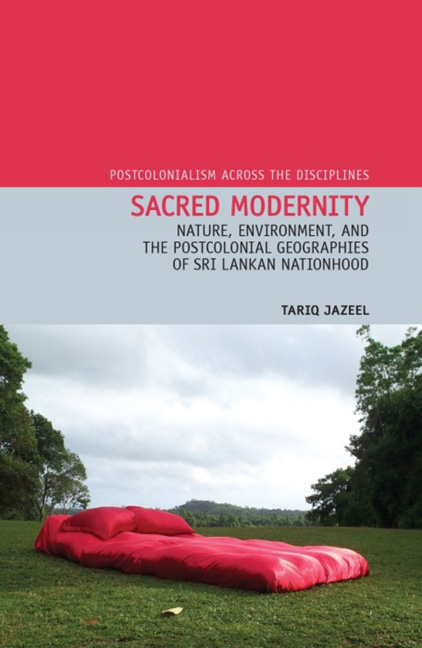Book contents
- Frontmatter
- Dedication
- Contents
- List of Map and Figures
- Acknowledgements
- Introduction
- 1 Sacred Modernity: Nature, Religion, and the Politics of Aesthetics
- Part I Ruhuna (Yala) National Park
- 2 Landscape, Nature, Nationhood: A Historical Geography of Ruhuna (Yala) National Park
- 3 Inscription and Experience: The Politics and Aesthetics of Nature Tourism
- 4 Political Geographies: Promoting, Contesting, and Purifying Nature
- Part II Tropical Modern Architecture
- Conclusion: Sri Lankan Nature as Problem Space
- Bibliography
- Index
2 - Landscape, Nature, Nationhood: A Historical Geography of Ruhuna (Yala) National Park
from Part I - Ruhuna (Yala) National Park
- Frontmatter
- Dedication
- Contents
- List of Map and Figures
- Acknowledgements
- Introduction
- 1 Sacred Modernity: Nature, Religion, and the Politics of Aesthetics
- Part I Ruhuna (Yala) National Park
- 2 Landscape, Nature, Nationhood: A Historical Geography of Ruhuna (Yala) National Park
- 3 Inscription and Experience: The Politics and Aesthetics of Nature Tourism
- 4 Political Geographies: Promoting, Contesting, and Purifying Nature
- Part II Tropical Modern Architecture
- Conclusion: Sri Lankan Nature as Problem Space
- Bibliography
- Index
Summary
Deep in Sri Lanka's arid southeastern coastal fringes, some 309 miles from Colombo, is Ruhuna National Park, or ‘Yala’ as it is more commonly known. The park itself has five ‘blocks’, although the area known as ‘Yala’ comprises a contiguous system of nine National Reserves (Map 1) covering 377 square miles. Because of the civil war and the security threats posed by the LTTE, between the late 1980s and early 2000s only Blocks I and II were open to the public. Through the late 2000s, in a bid to protect wildlife from the disturbances of tourism, only Block I was open to the public. Since its designation as a National Park in 1938, Ruhuna has remained one of the most popular of a nationwide network of National Reserves in Sri Lanka, attracting hundreds of thousands of nature lovers annually. In 1995, for example, there were approximately 245,000 visitors to the park, most of whom were classified as domestic (Sri Lankan) tourists, though a significant number were foreign tourists (Panwar and Wickeramasinghe 1997). The park itself has thorn bush landscapes interspersed with pockets of fairly dense secondary forest comprising its ‘jungles’. It is dotted w ith plains where animals can be observed at ease, and water holes as well as rocky outcrops where leopards and bears can be seen. With over thirty-five leopards spotted in Block I alone, Ruhuna claims one of the world's densest leopard populations. The Park is also replete with elephants, sambhur, buffalo, deer, wild boar, snakes, lizards, crocodiles, and an abundance of bird life.
National Parks in Sri Lanka are designated areas reserved for wildlife into which people may enter on permits issued by the Department of Wildlife Conservation (DWC). They appeal to tourists, weekend trippers, and wildlife enthusiasts alike. Visitors travel to the Park either having booked permits from the DWC in advance or with the intention of purchasing them at the Warden's bungalow. Accommodation is available in a handful of bungalows situated inside Block I, each sleeping between five and ten adults, though these must be booked in advance. Alternative accommodation is available either in campsites within the Park or in small hotels and guesthouses close by.
- Type
- Chapter
- Information
- Sacred ModernityNature, Environment and the Postcolonial Geographies of Sri Lankan Nationhood, pp. 27 - 46Publisher: Liverpool University PressPrint publication year: 2013



